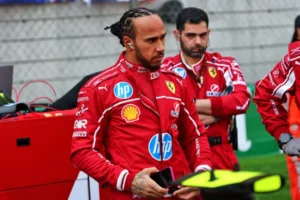Hamilton’s Disqualification Sparks Calls for FIA Rule Changes…read more

Hamilton’s Disqualification Sparks Calls for FIA Rule Changes
Lewis Hamilton’s disqualification from the Chinese Grand Prix has triggered a debate over whether the FIA’s technical regulations should be adjusted to account for minor infractions. The seven-time world champion was stripped of his results after post-race inspections revealed that the plank underneath his Mercedes had worn down 0.5mm beyond the 9mm minimum required by the FIA’s rules.
The decision was based on a breach of Article 3.5.9 of the FIA’s technical regulations, leading to an automatic disqualification. While the FIA and Mercedes acknowledged the infraction was unintentional, the ruling reignited discussions about whether the governing body should reconsider the severity of punishments for minor rule breaches.
Debate Over Strict Regulations
Former Ferrari driver René Arnoux was among those who criticized the decision, arguing that a small irregularity like Hamilton’s plank wear should not result in an immediate disqualification. He suggested that the FIA introduce a warning system before imposing strict penalties for such infractions.
“I don’t believe there was any intent to cheat,” Arnoux told La Gazzetta dello Sport. “If Leclerc’s car had been 10 kilograms underweight, or if the irregularity on Hamilton’s car was more substantial, then it would be a different story. But in this case, we are talking about trivial details that were evidently accidental.”
Arnoux acknowledged the importance of upholding the rules, particularly regarding car weight, which plays a crucial role in performance. However, he argued that the FIA should introduce a tolerance range for minor violations, allowing teams to receive a warning for their first offense rather than an immediate penalty.
“If things are this complicated, where mere millimeters can determine a disqualification, and if keeping everything in check is so difficult, then it would be wise to introduce a range within which minor infractions result in a warning,” he added. “Only if a team commits the same violation again should a disqualification be enforced. This kind of ruling has repercussions on the entire championship, not just the team or driver penalized.”
Wider Impact on the Grid
Hamilton was not the only driver affected by strict FIA regulations in Shanghai. Ferrari’s Charles Leclerc and Alpine’s Pierre Gasly were also disqualified from the race after their cars were found to be underweight by 1kg.
Leclerc’s disqualification came as a blow to Ferrari, especially since the team had been contending for valuable points in the championship. Similarly, Gasly’s removal from the results hurt Alpine’s standings in an already competitive midfield battle.
The FIA’s enforcement of strict technical regulations is not new, but the Chinese Grand Prix incidents have added momentum to calls for reform. Some argue that while maintaining fairness is essential, penalties should be proportional to the severity of infractions. Others, however, believe that any deviation from the rulebook—no matter how small—could open the door to teams pushing the limits further if given leniency.
As Formula 1 continues its season, the debate over whether the FIA should implement more flexible penalties for minor technical violations is likely to intensify. With teams constantly innovating and margins between success and failure often coming down to fractions of a millimeter, the governing body faces the challenge of balancing strict enforcement with fairness in competition.
Whether the FIA will revisit its rulebook in response to these latest controversies remains to be seen, but Hamilton’s disqualification has undoubtedly reignited the conversation about the rigidity of Formula 1’s regulations.








